 LIVING in WICHITA
LIVING in WICHITA
NOTE: Except as noted, these comments are the opinions, perceptions or recollections of the author. No guarantee of accuracy is made; however a reasonable effort has been made to realistically reflect the author's life-long familiarity and involvement with the community.
Following are some notable details about Wichita's...
LIFE
basic Wichita lifestyle and living conditions
EDUCATION
schools, libraries, museums
AESTHETICS, ARTS & CULTURE
music, art, theater, media
MEDIA
TV, radio, newspapers & magazines
EVENTS, VENUES & RECREATION
public & private events (festivals, fairs, sports, air shows, parades, etc.), and venues (civic centers, arenas, stadiums, theaters, auditoriums, hotel & motel convention /meeting facilities), parks, sports complexes, golf courses, and amusement venues and entertainment districts.
...with links to...
evaluating Wichita's lifestyle accommodations.
WICHITA LIFE:
Most Wichitans have a comparatively simple lifestyle, compared to the fast pace and drama of America's East and West Coasts -- and Wichitans generally live rather basic, working-class lives, in safe, comfortable, single-family houses -- at a fraction of the cost of comparable accommodations on the coasts.
 Though many Wichitans live in apartments, condominums, small houses or mobile homes, most Wichitans enjoy a large house, large grassy yard with trees, garage and private drive.
Though many Wichitans live in apartments, condominums, small houses or mobile homes, most Wichitans enjoy a large house, large grassy yard with trees, garage and private drive.
Air-conditioning is important in summer, and heating is truly essential in winter. Winds are strong and storms are not rare. But many days are sunny and mild -- especially in spring and fall.
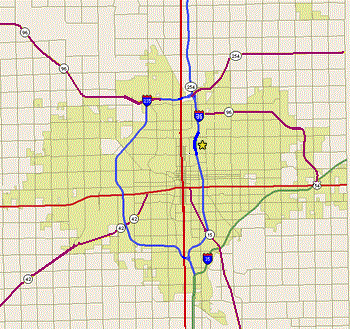 Owing to a low population density, and good streets and highways providing smooth connections between home and work, commuting to work is seldom more than a 20-minute drive in rush-hour traffic, and often half that. Shopping ranges from corner convenience stores to drive-up strip malls to walk-in regional malls, and a newly revived downtown.
Owing to a low population density, and good streets and highways providing smooth connections between home and work, commuting to work is seldom more than a 20-minute drive in rush-hour traffic, and often half that. Shopping ranges from corner convenience stores to drive-up strip malls to walk-in regional malls, and a newly revived downtown.
But life is more than driving, shopping, and going home. Here are some details on other aspects of life in Wichita:
EDUCATION:
Wichitans come in a wide range of education -- from a broad working-class group of high-school dropouts (as the state's major urban center, it has one of Kansas' highest dropout rates), to nationally-noted academics and professionals with doctoral degrees.
Several figures of national prominence in their field are alumni of Wichita's schools, colleges and universities,
including (as a small sample), former U.S. Defense Secretary (under Presidents G.W. Bush & B. Obama) Robert Gates, Broadway and Metropolitan Opera star Karla Burns, TV star Don Johnson, football Heisman Trophy winner Barry Sanders, the world's first three-minute-mile runner Jim Ryan, and numerous leaders in aviation. Longtime PBS News Hour anchor, Jim Lehrer -- famed for chairing several presidential debates -- recalled of his Wichita upbringing that "the public schools in Wichita were fabulous in the 1940s."
This EDUCATION section details Wichita's...:
SCHOOLS & COLLEGES:
The city is served by a city-wide public school system, several private schools, local campuses of three neighboring community colleges (from Butler and Cowley County, and Hutchinson), two private universities (Newman and Friends), a state university (Wichita State), and a medical college of another state university (KU Med).
Several additional private, commercial colleges and universities also operate in the area, as well, along with a public vocational college. Finally, the area is also a major center of aviation research and training.
Details follow:
Elementary & Secondary Education:

Wichita's public schools face the burden of educating a complex urban population -- while dependent upon state funding that requires constant funding battles with rural and small-town schools which have greater clout in the state capital. The Koch-guided Brownback administration and state legislature have begun drastic cuts to education, state-wide, and Wichita has been among the districts hardest hit.
The Kansas Supreme Court, in early 2016, threatened an indefinite shutdown of all Kansas public schools, starting in mid-summer, if the Governor and Legislature continue to fail to fund the state's schools "adequately" and "equitably" -- as required by the state constitution.
(UPDATE: May 27, 2016, the Kansas Supreme Court, today, ruled the state's latest school-funding formula unconstitutional, rejecting it because it unfairly disadvantaged children in urban districts, particularly Wichita.)
(UPDATE: 2019, Following the departure of Gov. Brownback, and particularly upon the election of Democrat Gov. Laura Kelly, the Republican-dominated Kansas Legislature -- responding grudgingly to court orders and public opinion -- has largely re-funded the Kansas public schools, to a level roughly comparable to the pre-Brownback era.)
Further, owing to the racial bias, economic snobbery, and libertarian and religious-conservative attitudes of much of the community, Wichita's public schools face stiff competition from a large array of "white flight" private schools who absorb many of the more-fortunate, easier-
 to-educate students in the district, leaving the Wichita Public Schools struggling with the most needy students.
to-educate students in the district, leaving the Wichita Public Schools struggling with the most needy students.
Those who prefer their children to be raised in "lily white" schools, under strict moral codes, find ample opportunity (if they are sufficiently well-off) in Wichita's dozens of church and "elite" schools. Local programs also support "home schooling."
 However, in recent years, the Wichita Public Schools (driven largely by the Bush/Obama "No Child Left Behind" programs, and in a desperate need to recruit more upscale students), have sharply improved their teachers, schools, and graduation rates, and radically expanded the quality of educational offerings.
However, in recent years, the Wichita Public Schools (driven largely by the Bush/Obama "No Child Left Behind" programs, and in a desperate need to recruit more upscale students), have sharply improved their teachers, schools, and graduation rates, and radically expanded the quality of educational offerings.
This includes the elite, globally-renowned "International Baccalaureate" program for dedicated, high-performing students. The Wichita Public Schools also include "magnet schools" providing specialized education in specific fields, including science and technology, peforming arts and others, as well as a more rigid "traditional" magnet school.
For much more detail on Wichita's schools,
see the School District section,
on this site's GENERAL page.
Vocational Education:
Like most places in the U.S., Wichita struggles with its vocational education programs. A lack of community support led to the Wichita Public Schools spinning-off their "Wichita Area Vocational/Technical School" (WAVTS) as a separate, independent entity -- Wichita Area Technical College (WATC). WATC offered a wide range of technical and industrial education -- chiefly focused on serving the area's aircraft factories.
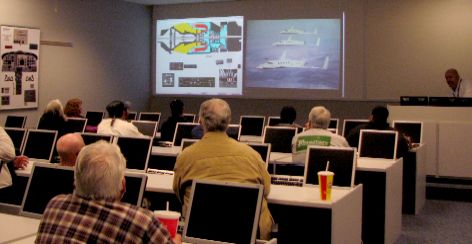 Lacking enthusiastic public funding, WATC programs were quite expensive -- more like private schools than a public institution.
Lacking enthusiastic public funding, WATC programs were quite expensive -- more like private schools than a public institution.
(UPDATE: 2018: WATC was absorbed by Wichita State University, becoming "WSU Tech".
It now operates on multiple campuses, particularly at the NCAT (see below) and in southeast Wichita at the East Harry Street campus, between Hillside Ave. and Oliver St.)
Several private vocational colleges are available in the Wichita area, a few of long standing. Of particular note is Wichita Technical Institute (WTI), in southwest Wichita -- offering training in various technologies (particularly electrical, electronics and computers) and health care (chiefly nursing).
However -- as in most other places, nationwide -- most of Wichita's private vocational colleges have earned bad reputations for inadquate education, high costs, unreasonably strict rules, high failure rates, and low student career-success rates -- often saddling students with several thousands (even tens of thousands) of dollars of debt, without the education and certification adequate to earn their way out of that debt.
And similiar accusations have also been leveled at the area's public colleges and university, as well. Of course, in Wichita -- as elsewhere, nationwide -- there are essentially no performance standards for college teaching, and no direct, substantial consequences for underperforming college educators, nor for their underperforming colleges or universities.
Community Colleges:

Community colleges of neighboring communities
(Cowley County, Butler County, Hutchinson)
all have Wichita-area campuses, offering both
vocational certification courses and traditional collegiate degree programs.
Their vocational programs, depending upon college, include industrial & trades skills — such as automotive, general mechanical, plumbing, electrical, and electronics — and certificate or degree training in computers, nursing, retailing and food-service. Programs range from one-year certificates to two-year Associate's degrees -- commonly
Associate of Applied Science (AAS) and
Associate of Science (AS) degrees.
In addition to vocational training, the three area community colleges offer a wide range of curricula, including Associate of Arts (AA) and
Associate of Science (AS) degrees in the full range of classical studies (liberal arts and sciences) and occupations (business, heatlhcare, technical and commercial).
Costs for attending these "junior" colleges can be far less than at the four-year universities. Also, class sizes are smaller and personal attention is easer to get.
The State of Kansas requires its four-year state universities to largely recognize a two-year degree (Associate of Arts, or Associate of Science), from a Kansas community college, as meeting the core requirements for the first two years of a four-year university (Bachelor's degree) program. This can substantially reduce the costs of a four-year degree. However, Kansas' four-year state universities (including Wichita State) are not consistently reliable partners in that program.
Universities & Other Colleges:
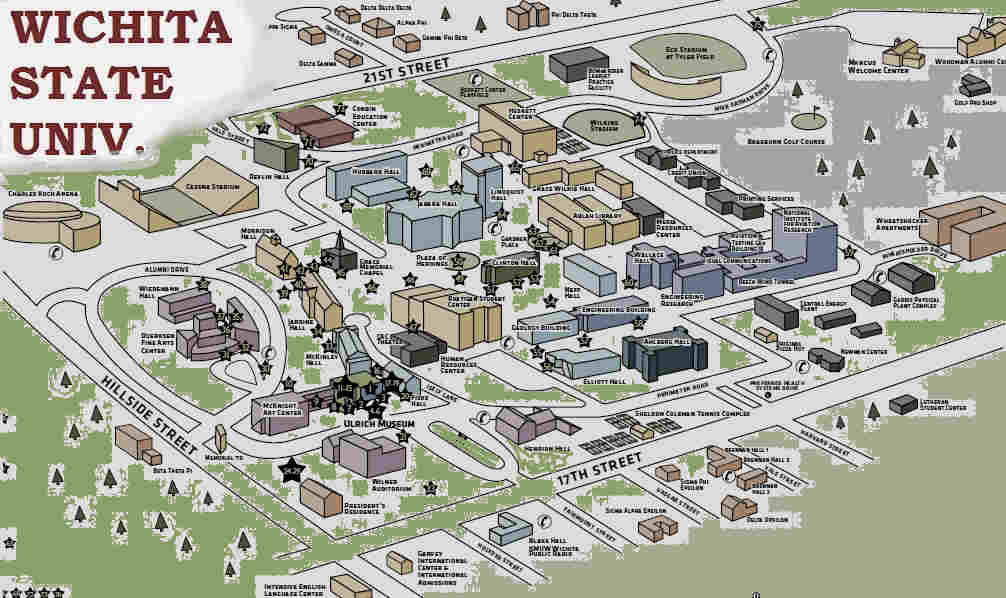 The area's dominant
The area's dominant
four-year educational institution is Wichita State University (WSU) -- a 12,000-student, half-square-mile campus in northeast Wichita. Long a capable university across all six colleges (Liberal Arts & Sciences, Business, Engineering, Healthcare, Education and Fine Arts), WSU has long had a national reputation in several areas -- including:
- Engineering (graduating some of the biggest names in the U.S. aerospace industry),
- Entrepreneurship (one of the first such programs in the U.S.),
- Forensic Anthropology (one of the oldest major programs in the U.S.),
- Speech Therapy (working with WSU, the nearby former "Institute of Logopedics" -- now "Heartspring" -- was once a world leader in the field), and
- Opera (some of New York's Metropolitan Opera stars have been WSU alumni).
However, recent economic pressures, resulting from the libertarian shift of state politics -- under extreme pressure from local billionaires, the Koch brothers (who have long opposed government funding of education) -- have changed WSU radically. Under the Kochs' long-time beneficiary, Kansas Governor Sam Brownback, his Kansas Board of Regents appointed an unusual new president for the University, who quickly began firing and retiring most of WSU's executives, deans and department chairs -- replacing them with people of generally lesser credentials, but greater compliance -- followed by a series of aggressive moves towards support of the Kochs' Libertarian opposition to government-funded education.
The university is now receiving a dwindling level of government support -- only partially offset by Koch donations -- and is under increasing pressure to become a commercial institution. Students are now being exploited commercially, whenever and however possible, and the WSU colleges that produce access to money through college/business partnerships or profitable innovations (the Colleges of Business, Engineering, Healthcare) are given priority over the other WSU colleges (Liberal Arts & Sciences, Education, Fine Arts). Sports are of increasing importance to the Univesity, as well: Although WSU has national reputations in baseball, basketball and bowling, pressure is on to expand these programs, and others, into commercially profitable operations.

Two mid-sized private universities, Friends University (shown at left) and Newman University -- near each other on Wichita's west side -- provide classical four-year degree programs, and Masters programs, in the liberal arts and sciences, fine arts, business and nursing. Newman is a Catholic university and Friends is a Quaker university, but both are open to all faiths, and to non-religious students, as well. Many Wichita-area students get their occupational training, or advanced degrees, at these institutions. The two universities also coordinate some educational programs or credits with each other, for the convenience of students. Friends is also famed for its music programs, particularly choral and religious music.
The University of Kansas (KU) School of Medicine (UKSM, better known as "KU Med"), based in Kansas City, also has a major Wichita campus (UKSM-W), which now trains physicians and surgeons on campus, and at the city's three large regional hospitals.
Commercial Colleges & Universities
Wichita has a long and checkered history with various private, commercial colleges & universities -- some local, and some operating Wichita campuses from out-of-state headquarters. None have stellar reputations. Among those that have operated here (most of which have disappeared, often with students' money), include:
- Bryan Institute
- Wichita Business College
- ITT Technical Insitute
- Vatterott College
- Phoenix University
- National American University
Also, other regular private colleges in Kansas have operated branch campuses here, but largely like commercial colleges.
- Baker University
- Tabor College
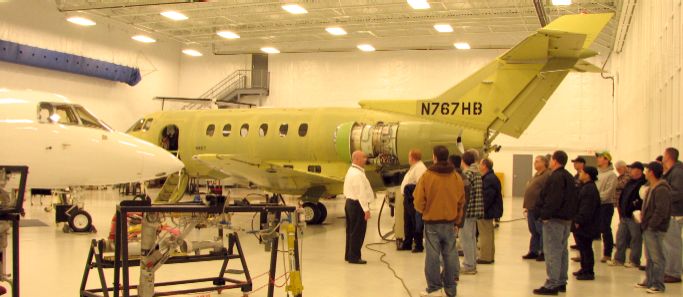
Aviation Education:
A unique sub-culture of Wichita-area education is aviation industry training. Wichita is one of the world's leading centers for aircraft manufacturing (locals build most of the Boeing 737 -- the world's most popular jetliner -- and Wichita-based companies have long built most of America's business jets, military trainers, commuter airliners, and light aircraft). Wichita is also home to an Air Force base. Consequently, aviation training is a major industry here. Local colleges provide aviation-related technical, engineering and business courses, certificates and degrees.
 WATC's "National Center for Aviation Training" (NCAT), at Jabara Airport, trains aircraft technicians, mechanics and machinists. The world's largest commercial pilot-training and mechanic-training service, FlightSafety International (with campuses around the city) provides specialized advanced training for hundreds of pilots and mechanics, every year, from around the globe -- teaching them to fly and fix the aircraft that Wichita produces. McConnell Air Force Base, too, has a history of training operations, as well, and hosts a branch campus of Florida's noted Embry-Riddle Aeronautical University (ERAU). And basic and advanced civilian pilot training (glider, airplane, and helicopter) is available from commercial operators at several of the 19 Wichita-area airports.
WATC's "National Center for Aviation Training" (NCAT), at Jabara Airport, trains aircraft technicians, mechanics and machinists. The world's largest commercial pilot-training and mechanic-training service, FlightSafety International (with campuses around the city) provides specialized advanced training for hundreds of pilots and mechanics, every year, from around the globe -- teaching them to fly and fix the aircraft that Wichita produces. McConnell Air Force Base, too, has a history of training operations, as well, and hosts a branch campus of Florida's noted Embry-Riddle Aeronautical University (ERAU). And basic and advanced civilian pilot training (glider, airplane, and helicopter) is available from commercial operators at several of the 19 Wichita-area airports.
LIBRARIES:
Until recently, a large, sprawling, modern, three-story Wichita Public Library was Downtown, on Main Street a block south of Douglas -- between the giant, round Century II civic center and the castle-like Wichita / Sedgwick County Historical Museum.
(UPDATE:
The popular old library has been replaced with a costly, controversial facility -- less-conveniently located northwest of downtown, between the river and McClean Boulevard, near Exploration Place)
The original main library (and, for the most part, the new library) includes:
- A very large selection of books, magazines and newspapers, on every concievable topic, and by every major author, conveniently organized by the Dewey Decimal System (non-fiction books by subject; fiction books by author), with computers and staffers available to help find books.
- Free computer use and internet access, (on a limited-time, scheduled basis, on several computers), as well as free wi-fi internet access for those with their own devices. Printer access is available for 10 cents a page.
- Numerous power outlets accommodating patrons' own electronic devices. Free wi-fi (with a password, for those with a library card).
- Meeting Rooms & Auditorium (rentable): Ranging from small conference rooms to large 150-plus-seat auditorium with digital projector and sound system. The Auditorium is common venue for Library educational programs and many local civic gatherings.
Special Departments:
- Childrens' section: A separate childrens' library, supervised by a children's librarian, with child-friendly furniture and surroundings, occasionally with readings or other activities for children.
- Special Collections archives (basement): Special, old, historic and locally-important books, documents and pictures, and microfilm/microfiche with readers. City Historian is the Special Collections curator, and normally attends the room. However, a declining emphasis on local history by library officials has reportedly led to the discarding of much of the department's archives, and the library's officials declining to accept significant offerings of historical materials for the archives, for lack of allocated space.
- Business & Technical section: Extensive reference books and periodicals on business and technolgy topics, not only the normal books and magazines in such fields, but special resources ranging from business directories, to aircraft reference books, to technical repair guides for vehicles, appliances and electronics, to the latest business-trend books and how-to manuals for technical hobbies, to tax forms (during tax season). Typewriters and computers are free, as available.
- Art & Music room: A sprawling library of video and music recordings and artwork (mostly prints of paintings), which can be checked out, or enjoyed there. Includes record-players and tape-players available free, with headphones, for listening on-site. Includes educational and entertainment videotapes and discs. Also a good, quiet place to plug in and use your own laptop computer, with wi-fi (ask at art librarian's desk for directions to the right place).
- Special programs & exhibits: The library staff often offers free public programs on various topics of intellectual and recreational interest -- typically one-hour classes or presentations, or some longer, or multiple-session programs, including limited computer classes. A monthly program guide is available, and scheduled activities are usually posted on the libarary website: wichitalibrary.org.
BRANCH LIBRARIES:
Several branch libraries dot the city in strategic locations, and offer substantial selection of books, magazines and newspapers, free computer use (on a limited-time, scheduled basis) with internet access, usually one or more meeting rooms (rentable), and a childrens' section. Books can be ordered from the main library, and picked up at the branch.
SPECIAL LIBRARIES:
Several special libraries around the city provide added resources, though some are restricted access and/or restricted use. Of particular note are:
- University Libraries:
At Wichita's four local universities, all of them substantial. By far, the greatest is the huge Ablah Library at Wichita State University. It is open to the public, but checking out books or using special resources requires a college ID or -- in some cases -- a Wichita Public Library card.
- Trade Libraries:
The Wichita / Sedgwick County Law Library, downtown, provides lawyers with a very wide array of law books. Some major local companies have their own internal libraries with a broad array of trade-specific information, usually accessible only to employees (and not all of them).
- Museum libraries: Most local museums have a sizeable collection of books on the museum's subject area. Of particular note is the library at the Kansas Aviation Museum. However, access and use tend to be very limited.
MUSEUMS:
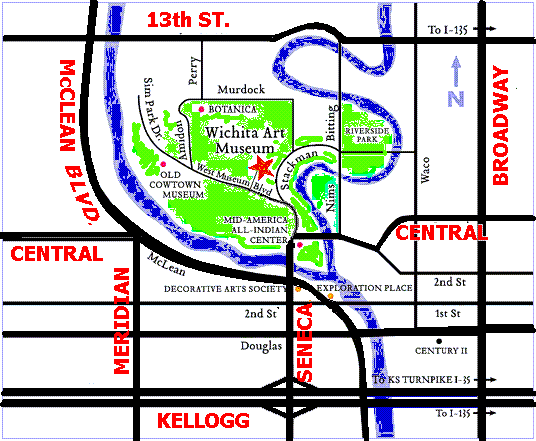
Map of Wichita's "Museums on the River"
...
- Wichita Art Museum: the red star in the center.
- Botanica: the red dot above (north of) the star
- Cowtown: the red dot right (west) of the star
- Mid-America All-Indian Center: the red dot below (south of) of the star
- Exploration Place: the red dot below (south of) the Indian Center, at 1st St. & McClean Boulevard
Wichita has a remarkable array of museums, from historical, to art, to science and technology, and some with a mix of these. Most have gift shops. Some (particularly Cowtown Museum and Exploration Place) are family-friendly recreational / educational museums. Here are some of the principal local museums:
Historical / Archaeological Museums:
- Museum of World Treasures:
 One of the most spectacular collections of antiquities, archaelogical and pre-historic treasures in the Midwest. From fossils to dinosaur skeletons, to Babylonian figurines, to Egyptian sarchophogi, to Roman coins, to medieval weapons, to handwriting of all the famous royals of Europe, and all the Presidents of the U.S., to war relics and modern treasures. Something for everyone.
One of the most spectacular collections of antiquities, archaelogical and pre-historic treasures in the Midwest. From fossils to dinosaur skeletons, to Babylonian figurines, to Egyptian sarchophogi, to Roman coins, to medieval weapons, to handwriting of all the famous royals of Europe, and all the Presidents of the U.S., to war relics and modern treasures. Something for everyone.
- Wichita / Sedgwick County Historical
Museum:
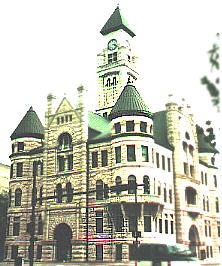 (Downtown, in the grand castle-like old City Hall, at Main and William, across the street from the Library and Century II, and a block south of Douglas.)
(Downtown, in the grand castle-like old City Hall, at Main and William, across the street from the Library and Century II, and a block south of Douglas.)
This is the area's principal museum, and host to excellent exhibits illustrating the history and culture of Wichita and south-central Kansas. Very inexpensive.
- Cowtown Museum:
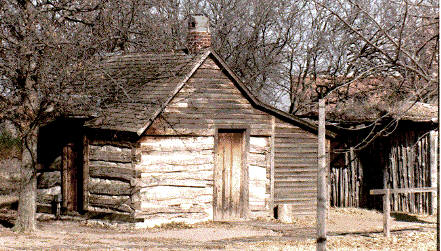 Exceptionally realistic recreation of early Wichita -- with many of its original buildings: blacksmith's shop, stable, jail, saloon, store, early home, and other places of interest. Character re-enactors and guides, in authentic garb, portray pioneer Wichitans, including cowboys and farmers, a blacksmith,
bartender, storekeeper, gentle ladies and saloon gals, and more.
Exceptionally realistic recreation of early Wichita -- with many of its original buildings: blacksmith's shop, stable, jail, saloon, store, early home, and other places of interest. Character re-enactors and guides, in authentic garb, portray pioneer Wichitans, including cowboys and farmers, a blacksmith,
bartender, storekeeper, gentle ladies and saloon gals, and more.
 Shootouts may happen on short notice. Family-oriented, educational & fun, and a true-to-life disconnect from the modern world. Seasonal. (Northwest of downtown, near Wichita Art Museum and Mid-America All-Indian Center)
Shootouts may happen on short notice. Family-oriented, educational & fun, and a true-to-life disconnect from the modern world. Seasonal. (Northwest of downtown, near Wichita Art Museum and Mid-America All-Indian Center)
- Mid-America All-Indian Center:
Small Native American museum and gift shop in large Indian Center, with its auditorium (kiva) for Native American events.
 Celebrates Wichita's extraordinary diversity of "Indians"-- one of the largest urban concentrations of Native Americans in America.
Occasional dances, pow-wows, and other events. Just west of downtown, across the river, behind the towering "Keeper of the Plains" Indian statue at the juncture of the rivers.
Celebrates Wichita's extraordinary diversity of "Indians"-- one of the largest urban concentrations of Native Americans in America.
Occasional dances, pow-wows, and other events. Just west of downtown, across the river, behind the towering "Keeper of the Plains" Indian statue at the juncture of the rivers.
- Anthropology Dept. Museum

(Wichita State University):
What the wandering professors and scholars of WSU have brought back from the far corners and remote regions of the world.
Science & Technology Museums:
- Exploration Place:
(On the west bank of the river, immediately northwest of Downtown, on McClean Boulevard. Odd-looking gray concrete building with sweeping curves.) Exciting, interactive science-and-technology museum, includes many hands-on activities for young and old. Includes such exceptional features as flight simulators and interactive wind-tunnels, planetarium and IMAX dome theater. VERY expensive, but you won't regret it. Come early, stay a long time. Do everythig. Kids will LOVE it.
- Great Plains Transportation Museum:
("The Train Museum")
(On Douglas, east of downtown, immediately east of the railroad overpass.) Large collection of old, and not-so-old actual locomotives & railroad cars (including some you can climb around in) on the tracks over and near the railroad overpass -- plus a small museum of railroad artifacts. (about $8 for adults). Very occasional visits by trains providing short rides, for a modest price.
- Kansas Aviation Museum:
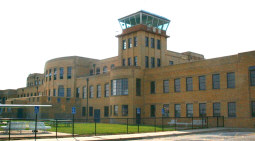 Fairly large museum of Kansas aviation history. Exhibits of several aircraft (including one of the world's largest museum collections of big Boeing jets), especially aircraft built in Kansas. Play room includes a aircraft cabins and cockpits you can climb in, and computer-screen flight-simulators you can "fly."
Large exhibits of aircraft models, engines & other aviation memoribilia, in historic old airport terminal. Able-bodied visitors can climb to the control tower for the highest view available of Wichita, McConnell Air Force Base, and their surroundings. Modestly priced (about $7/person). (In far Southeast Wichita, at the end of George Washington Boulevard, next to the air base.)
Fairly large museum of Kansas aviation history. Exhibits of several aircraft (including one of the world's largest museum collections of big Boeing jets), especially aircraft built in Kansas. Play room includes a aircraft cabins and cockpits you can climb in, and computer-screen flight-simulators you can "fly."
Large exhibits of aircraft models, engines & other aviation memoribilia, in historic old airport terminal. Able-bodied visitors can climb to the control tower for the highest view available of Wichita, McConnell Air Force Base, and their surroundings. Modestly priced (about $7/person). (In far Southeast Wichita, at the end of George Washington Boulevard, next to the air base.)
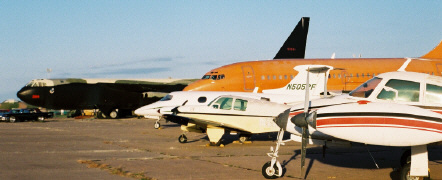
Art Museums:
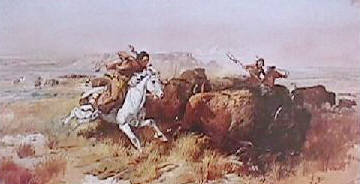
- Wichita Art Museum:
Extensive collection, including exceptional collection of modern and cowboy/western art, by famed artists. Ritzy cafe. Northwest of downtown, near Cowtown and Mid-America All-Indian Center)
- Mark Arts (Mary R. Koch Center for the Arts):
Extensive collection, including exceptional collection of modern art. Art classes are taught here. On far east side, on Central Ave. near Webb Road.
- Ulrich Museum of Art sculpture exhibits
(Wichita State University):
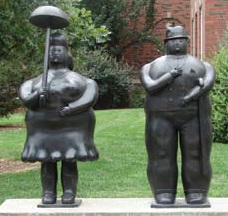 University's art museum. Surrounding campus is covered with dozens of great sculptures by the most famous sculptors of modern times: Rodin, Miro, etc. -- one of the most spectacular
sculpture collections in any American city. NorthEast/Central Wichita, just north of 17th, two blocks east of Hillside.
University's art museum. Surrounding campus is covered with dozens of great sculptures by the most famous sculptors of modern times: Rodin, Miro, etc. -- one of the most spectacular
sculpture collections in any American city. NorthEast/Central Wichita, just north of 17th, two blocks east of Hillside.
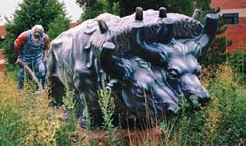
- CityArts:
Official city cultural administration building, with tiny exhibit space used to showcase local art and artists -- particularly those who patronize the Center and its classes. In Old Town next to Warren Theater, just north of 2nd St., just west of the rail overpass.
AESTHETICS, ARTS & CULTURAL AFFAIRS:

The rural/industrial roots of Wichita shape its dominant tastes, but its history of wealth has also brought access to "fine arts" as well.
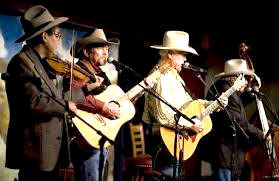 Both country/western and rock'n'roll music are popular here, with big-name performers in country music making Wichita a routine stop. Most major rock stars have performed here, as well, though not always at their peak. Pop, folk, blues, and bluegrass music get substantial attention here, as well. Local performers have become national stars (notably jazz sax pioneer Charlie "Bird" Parker, c/w star Martina McBride, "Eagles" guitarist Joe Walsh). Wichita is birthplace of the electric guitar and (by some accounts) the "fuzz box."
Both country/western and rock'n'roll music are popular here, with big-name performers in country music making Wichita a routine stop. Most major rock stars have performed here, as well, though not always at their peak. Pop, folk, blues, and bluegrass music get substantial attention here, as well. Local performers have become national stars (notably jazz sax pioneer Charlie "Bird" Parker, c/w star Martina McBride, "Eagles" guitarist Joe Walsh). Wichita is birthplace of the electric guitar and (by some accounts) the "fuzz box."
On the more elegant end of the entertainment spectrum, Wichita has one of the most sophisticated arrays of fine music, dance and theater resources, of any mid-sized, midwestern city -- including classical music (with long-standing symphony orchestra, ballet and opera companies, often attracting or spawning national talent, like Wichita-bred Metropolitan Opera stars Samuel Ramey and Karla Burns), backed by nationally renowned music programs at two local universities.
The Wichita Symphony Orchestra often hosts famous performers, as do the Wichita Grand Opera, Music Theater of Wichita, and Wichita Ballet -- all of whom have produced stars on the national stage, as has Wichita State University's school of music.
 The Wichita area has a wide range of theaters (motion picture and stage), and is home to an exceptional
wealth of museums (art, culture, history, science, aviation, sports, youth, and more) -- some of them achieving national notoriety.
The Wichita area has a wide range of theaters (motion picture and stage), and is home to an exceptional
wealth of museums (art, culture, history, science, aviation, sports, youth, and more) -- some of them achieving national notoriety.
Three major regional art museums are here, and Wichita State University is home to one of the
 nation's leading collections of outdoor sculpture, crafted by world-famous sculptors (Miro', Nevelson, Oldenburg, Rodin, etc.). (For more on the local art museums, see the MUSEUMS subsection, at the end of the EDUCATION section, immediately above.)
nation's leading collections of outdoor sculpture, crafted by world-famous sculptors (Miro', Nevelson, Oldenburg, Rodin, etc.). (For more on the local art museums, see the MUSEUMS subsection, at the end of the EDUCATION section, immediately above.)
An aggressive "historic preservation" effort, starting in the 1970s, has restored and revived many elegant buildings and homes, some of them a century old or more
 -- particularly including the downtown area, (now being massively renovated), and older districts and neighborhoods east, west and north of downtown.
-- particularly including the downtown area, (now being massively renovated), and older districts and neighborhoods east, west and north of downtown.
CityArts -- a department of City government -- provides various cultural opportunities, events and classes. A week-long spring festival (RiverFest) is popular, as are the local Rennaissance Fair, book fairs, monthly art-gallery "crawls," and a seasonal "Farm & Art Market." The local library system includes several branches, with various educational and cultural programs.
MEDIA:

TELEVISION:
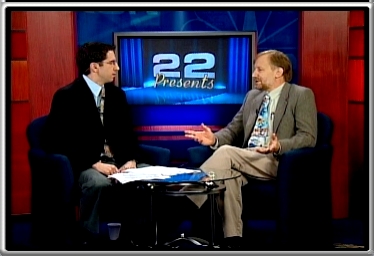 As the major media hub for most of Kansas, Wichita has TV stations for all the major broadcast networks -- including CBS, NBC, ABC, PBS, Fox, Univision and WB/CW. Cable and satellite TV providers, and low-power stations, offer hundreds more channels.
As the major media hub for most of Kansas, Wichita has TV stations for all the major broadcast networks -- including CBS, NBC, ABC, PBS, Fox, Univision and WB/CW. Cable and satellite TV providers, and low-power stations, offer hundreds more channels.
Most of Western Kansas watches the "Kansas State Network," a Wichita-based network of TV stations (KSN-W / NBC, Ch.3 in Wichita), or watches KWCH-TV (CBS, Ch.12) and KPTS-TV (PBS, Ch.8) -- both based in Wichita, but broadcasting from more-centrally located Hutchinson. Local ABC affiliate KAKE-TV (ABC, Ch.10) is a popular local station, and several low-power stations operate here as well.
RADIO:
Dozens of area radio stations provide almost every kind of music imaginable, from country to jazz, hard rock to gospel, foreign to folk, opera to hip-hop, as well as news and talk radio.
- FM:
Of the 39 area FM radio stations, about half are conservative Christian religious stations, or conservative national talk-show stations. The remainder include two public radio stations (NPR affiliates, one featuring classical and "space" music, another offering limited jazz, "alternative" and Celtic music, both with extensive news programming), about a dozen country-music stations, and several other music types, from "alternative rock," mainstream rock and pop, to "urban" (hip-hop/rap/R&B), Hispanic (in Spanish & English), and jazz, to soft "golden oldies."
- AM:
A similar mix spans the local AM dial, as well, though national conservative talk shows dominate the AM dial (as elsewhere nationwide).
NEWSPAPERS & MAGAZINES:
The area supports several newspapers (principally the Wichita Eagle & Beacon, the state's largest newspaper), and a few local magazines.
Wichita Business Journal
(local affiliate of the national chain of Business Journals.)
The Community Voice
(catering to African-Americans & inner-city Wichita)
The Sunflower
(student newspaper
of Wichita State University)
Other local newspapers range from
the light-content
East Wichita News and
West Side Story
to Spanish-language Hispanic community newspapers to local newspapers of the surrounding suburbs, to entertainment tabloids, and other niche publications. The magazine Splurge! functions as a sort of "social register" and lifestyle magazine for Wichita's white upper-middle-class and wealthy.
EVENTS, VENUES & RECREATION:

Wichita has a modest but substantial array of recreational opportunities, and occasions and venues for private and public events, celebrations, parades and parties. (Note: For music, stage and the arts, see the previous section:
AESTHETICS, ARTS & CULTURAL AFFAIRS:; for museums and libraries, see, see the previous section:
EDUCATION:). Wichita recreational sites include civic centers, arenas, stadiums, hotel & motel convention / meeting sites, parks, sports complexes, golf courses, recreation / celebration venues, and amusement facilities.
These topics are covered in this section:
PUBLIC & PRIVATE EVENTS:
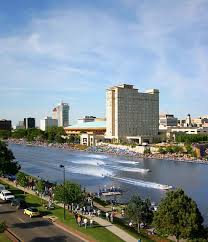 While the events in Wichita are, of course, far too numerous to list -- and many of them are one-time-only -- nevertheless there are a few key events in Wichita that are fairly regular, and widely attended. Here's a sampling. (For more information on local events, visit the city's semi-offical events website:
VisitWichita.org):
While the events in Wichita are, of course, far too numerous to list -- and many of them are one-time-only -- nevertheless there are a few key events in Wichita that are fairly regular, and widely attended. Here's a sampling. (For more information on local events, visit the city's semi-offical events website:
VisitWichita.org):
-
FESTIVALS, FAIRS & EXHIBITIONS:
-
General Festivals & Fairs:
-
RiverFest
Begun in the 1970s, and recently moved from May to June, Wichita's annual spring festival is the city's great annual party -- widely recognized as one of the nation's biggest annual community festivals. A week-long event, mostly in downtown, and largely around (or even in) the Arkansas River in mid-city, it includes parade, carnivals, comic boat races, stage performances, concerts and dances, fireworks, sporting events, odd competitions, exhibits, and vendors. Usually some (very pricey) helicopter rides are for sale. Attendance at several events and venues is free, though most require a moderately-priced "RiverFest button" -- available in Dillons grocery stores, convenience stores, and elsewhere throughout the city.
-
Kansas State Fair:
A classic state fair, rural in style, held in Hutchinson in the summer, an hour's drive from Wichita.
-
Sedgwick County Fair:
A classic county fair, rural in style, held in one of the more-rural communities in Sedgwick County, a short drive from Wichita.
-
Cultural Festivals & Fairs:
-
Renaissance Fair:
Commonly held in Sedgwick County Park -- in the Spring -- hundreds, sometimes thousands, attend, to see the local chapter of the SCA (Society for Creative Anachronism) strut about in medieval garb, hawking homemade wares of antique and/or artistic design, speaking in Olde English, engaging in mock combat, and performing various entertainments in the fashion of the Dark Ages. Fun (though often rain-drenched) entertainment for the young and young-at-heart.
-
Juneteeth (around June 19th)
Traditional African-American festival, originally around the anniversary of the full-distribution of the Emancipation Proclamation (June 19th, 1864). Typically held in McAdams Park, in northeast Wichita. Includes parade, politicians, popcorn, music, arts, crafts, African-American traditional food, historic and political exhibits, politicians roaming loose.
-
African-American Arts Festival
Popular local African-American cultural festival -- arts, crafts, food (especially traditional food), historic and political exhibits, politicians roaming loose -- at McAdams park. Many activities for kids.
-
Asian Arts Festival
Mind-blowing, stupendous, chaotic, massive cultural festival for Wichita's large Asian community -- typically filling Century II Civic Center -- with dozens of dazzling stage performances in native garb (music, dance, martial arts, acrobatics, and more), beauty pageant, vendors selling every kind of Asian food, clothing, arts and crafts, from every Asian culture imaginable -- from Arab and Afghan, to Indian and Pakistani, to Thai and Vietnamese, to Korean and Filipino, to Chinese and Japanese, and every nation in-between. Very affordable, with maximum bang-for-buck of any festival in Wichita (camera and empty stomach strongly recommended).
-
Mid-America Indian Pow-Wow
Cultural festival for Wichita's large Native American community, with numerous exhibits, music and dance performances, in rich traditional garb, ceremonies, historical exhibits, speeches, for a surprising diversity of tribes. Typically held at the Mid-America All-Indian Center (MAAIC) at the confluence of the Big and Little Arkansas Rivers, just northwest of Downtown, and north of Seneca and McClean Blvd, just over the bridge.
-
Commercial Festivals, Fairs & Exhibitions:
Wichita has a number of annual commercial festivals, fairs and exhibitions -- particularly at the Century II Convention Center complex -- which showcase and sell various types of goods and services. Some major events include...
- Bridal Fair (late winter / early Spring)
- Lawn & Garden Show (late winter / early Spring)
- Sport, Boat & Travel Show
- RV Show (recreational vehicles)
- WITS (Wichita Industrial Trade Show) (biannually, in October of odd-numbered years)
- Library Book Fair & Sale...
- gun shows...
- job fairs...
- and others...
PARADES:
Several parades are an annual event in Wichita -- some encouraging broad public participation -- particularly:
-
St. Patrick's Day
-
RiverFest (June)
-
Juneteeth (around June 19th)
-
Veteran's Day
-
Christmas (around Thanksgiving)
-
SPORTS:
Wichita has a modest-but-substantial array of sporting events -- minor-league baseball and hockey (and sometimes indoor soccer), WSU's championship college basketball, baseball and bowling teams (often very-highly-ranked), car racing, nearby rodeos, and more. Some college championship games are occassionally played in Wichita, and this is home to many high-school local and state tournaments (usually at WSU's Cessna Stadium). But few notable and reliable annual events occur in sports, here -- with one MAJOR exception:
-
World Series of the Minor Leagues
Wichita, as home to the National Baseball Congress (NBC), is the normal site of the annual "World Series" of the minor leagues, in the late Autumn. Top teams compete at Wichita's baseball stadium for the top national honors. (May be temporarily suspended, as the City baseball stadium has been demolished, and is being replaced, slowly).

- CAR SHOWS:
In addition to car-racing (noted above), car shows are a common element of Wichita entertainment. As is typical of Midwestern industrial cities, automobiles and their exhibition -- stock, restored, and/or customized -- are a very popular area hobby. In addition to the events listed below, other minor and informal car shows pop up from time to time throughout the Wichita area. Several car clubs invigorate and sustain the popular enthusiasm.
-
Darryl Starbird's Rod & Custom Show
Although it has morphed over the decades into various names, this remains one of the biggest car shows in the Central U.S. -- ranging from meticulously restored antiques, to hot-rod jalopy and 60s muscle cars, to exotic custom show cars -- all under the roof of Century II.
-
............... Show
This outdoor event covers much of West Downtown, and draws a national audience, with power cars and trucks of every kind and description.
-
Automobilia
Started sponsored by the local auto-memorabilia shop of the same name, this annual outdoor event occupies much of downtown.
-
Monster Truck Jam & related shows
Normally held in a local arena, these are spectacles of giant vehicles -- "monster trucks", cars, tractors, etc. -- engaged in flashy exhibitions, acrobatic feats, power shows, and mock combat. Billed as a "family" event.
-
Central & West St. informal show, warm Friday nights
Throughout the warm months, an informal gathering of auto enthusiasts assembles in the shopping center parking lot at the southwest corner of Central Ave. and West St. on fair-weather Friday nights. Open to all -- whether showing a car or not -- it's a fun, casual show of dozens of interesting local cars (often more than 50), with no charge for viewing.
-
Recreational Vehicle & Boat Shows
OK, not cars, exactly -- but these annual indoor events are a feast for the eye, showing off a splendid variety of new and luxurious recreational transportation for sale.
- AIR SHOWS:
An obvious event for the "Air Capital of the World" would be an air show, right? Yet, oddly enough, neither the city nor its aviation industry will commit to a regular annual event. Nevertheless, most years see either a city-sponsored (civilian) air show, or (more likely) a military show sponsored by (and at) the neighboring McConnell Air Force Base. One key rule for all Wichita air shows: Attend SATURDAY. If it gets rained out (as often happens) you can come back Sunday. If you wait until Sunday, though -- that's the day that will likely get rained out, and there's no show after that.
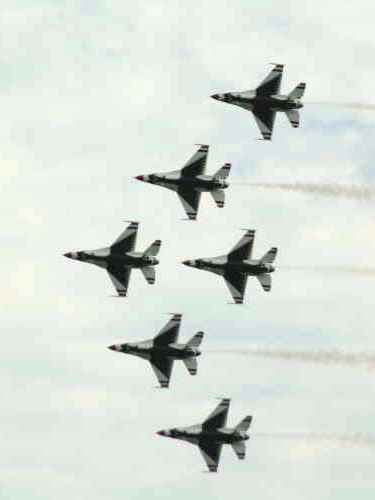
-
McConnell Air Force Base Open House
The more reliable of the two shows (typically once every two years, in September), this event is usually pretty spectacular, and often includes a visit from one or two of the nation's pre-eminent military exhibition teams -- the Air Force Thunderbirds, the Navy's Blue Angels, or the Army's Golden Knights skydivers -- in addition to a large display of military aircraft, ranging from fighter, attack and trainer jets to heavy transports (which you can walk through), tankers and an occasional bomber. Other flight exhibitions, civilian and military occur, and sometimes a few civilian planes (mostly locally-built business aircraft) are on display. Sometimes includes historic aircraft from the adjacent Kansas Avaition Museum.
-
Wichita (or "Kansas") Flight Festival
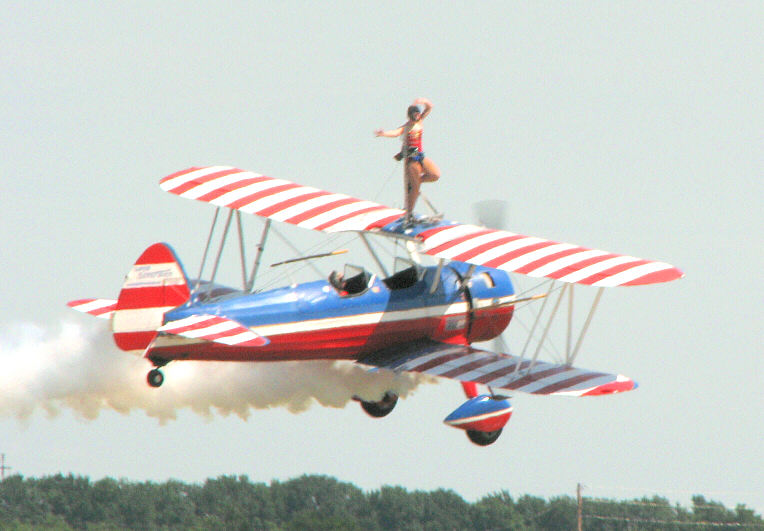 A weekend event, every few years, usually in September -- normally at Jabara Airport, northeast of the city. It usually includes some of the nation's top aerobatic performers and airshow acts -- mostly spectacular stunt exhibitions in high-performance light planes -- and a sizeable "static display" of parked airplanes, mostly light planes and locally-manufactured business aircraft, with some vintage and experimental aircraft. Usually some (very pricey) airplane and/or helicopter rides are for sale. A few exhibits and indoor events, and activities for kids. Though normally sponsored by the city government, it's a very low priority, and is skipped in most years.
A weekend event, every few years, usually in September -- normally at Jabara Airport, northeast of the city. It usually includes some of the nation's top aerobatic performers and airshow acts -- mostly spectacular stunt exhibitions in high-performance light planes -- and a sizeable "static display" of parked airplanes, mostly light planes and locally-manufactured business aircraft, with some vintage and experimental aircraft. Usually some (very pricey) airplane and/or helicopter rides are for sale. A few exhibits and indoor events, and activities for kids. Though normally sponsored by the city government, it's a very low priority, and is skipped in most years.
-
EAA Fly-In
A very modest weekend event, typically in Autumn -- sometimes held at a Wichita airport, sometimes in an adjacent county -- that is primarily a get-together and public fund-raiser for the local chapter of the EAA (Experimental Aircraft Association), a group of light-plane enthusiasts. Seldom has any aerobatic performances, but occassionally an interesting fly-by. Includes a modest "static display" of parked airplanes, mostly light planes, particularly vintage and experimental aircraft. A few exhibits and indoor events, and activities for kids -- including free, EAA-managed "Young Eagles" airplane rides (which require some advance preparation).
- OTHER EVENTS:
For other events -- partricularly concerts. stage productions, movies, and other fine arts -- see:
PUBLIC & PRIVATE VENUES:
Wichita has a rich array of public and private venues, including public and private arenas, entertainment & convention centers, and sports venues.
For downtown sites, the popular Delano shopping/dining district is right across the Douglas river bridge to the east, and Old Town shopping/dining/party district is a mile east, or less.
 Both areas are accessible by a free late-night trolley bus that makes the rounds downtown. Museums are all around the area. Century II is adjacent, with the Intrust Bank Arena in walking distance, about a half-mile away to the east.
Both areas are accessible by a free late-night trolley bus that makes the rounds downtown. Museums are all around the area. Century II is adjacent, with the Intrust Bank Arena in walking distance, about a half-mile away to the east.
Wichita's public & private venues include, in particular:
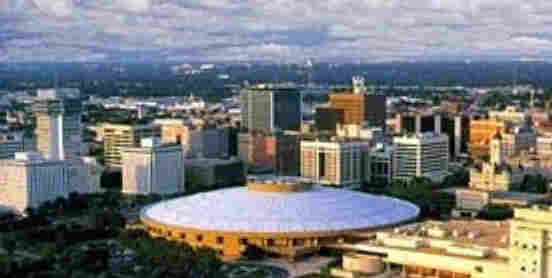
- Century II
civic complex
(West edge of Downtown, just west of Main Street on Douglas, at the river; identifiable by its huge, round, blue-domed main building; a huge, brown, rectangular exhibition hall building is attached to the south, and it attaches to the 10-story Wichita Hyatt Hotel.)
Century II is the city's main venue, for almost any large event. This massive complex includes huge exhibition halls, auditorium, concert hall, stage theater, and meeting rooms small and large. Extensive metered parking, and large free parking lot a half-block to the south. Attached to the Hyatt Regency hotel (see below), and across the street from the Drury/Broadview Hotel (see below), it offers a spectacular array of meeting and event accommodations. Often the site of multiple simultaneous events.
| Room |
Sq. Ft. |
Ceiling |
Exhibit |
Capacity |
|
(flat) |
Height |
Booths |
Theater |
Banquet |
| Expo Hall |
93,000 |
32' |
450 |
5,000 |
3,000 |
| Convention Hall |
32,000 |
31-49' |
110 |
4,751 |
1,120 |
|
Exhibition Hall |
45,000 |
31-36' |
160 |
3,000 |
1,848 |
| Exhibition Hall Balcony |
17,500 |
18' |
54 |
600 |
480 |
|
Concert Hall |
|
|
|
2,195 |
|
| Mary Jane Teall Theater |
|
|
|
652 |
|
For various reasons, political leaders are considering demolishing it, though much community support remains for the city's iconic civic center.
- The Cotillion
(far West Wichita, at 11120 West Kellogg, west of Maize Road).
An old, large, domed ballroom and banquet hall, popular for small concerts, and for very large meetings and parties. Adequate parking, but far from any other facilities or resources.
- Arenas:
- Intrust Bank Arena
(southeast downtown, near the tracks, at Waterman, a block south of Douglas on St. Francis.)

The city's controversial, new, main arena -- in a huge fancy building, but with steep interior seating bowl, and extremely cramped seating (people with acrophobia or claustrophobia often hate it). Access and parking situtation is disastrous: It's difficult to locate, and reach, then you must park in a tiny adjacent lot, or in parking garage across the street, or (more likely) on the surrounding streets and pricey private parking lots (fiercely policed), or on the other side of the long railroad tracks (a troubling location). Most big-name acts prefer this facility because it can pack a lot of people in -- but patrons generally hate it. Was intended to replace the old Sedgwick County Arena, north of the city, but has had many shortcomings and issues, owing to decisions by City Council and County Commission, and their assigned operatives.
- Hartman Arena
(North of Wichita, in adjacent Park City, on the west side of I-135, across from the old Sedwick County Arena), A large private arena, used for many concerts, school graduations, sports events and other events. Identifiable by a large wind turbine behind the building.
- Koch Arena (northeast Wichita, 21st and Hillside)
Wichita State University's round, domed arena, often called "the Roundhouse" -- or even by its original name "Henry Levitt Arena" -- this is one of the city's primary semi-public event venues. Commonly used for sporting events, college and high-school graduations, and concerts.
- Stadiums:
- Lawrence-Dumont Stadium (Downtown Wichita, west side of the River on Maple between McClean Boulevard and Sycamore): The city's baseball stadium, used almost exclusively for baseball games, particularly Wichita's minor league team, the Wingnuts. Home of the National Baseball Congress -- the organization of of America's baseball minor leagues -- this is the site of their annual national tournaments.
UPDATE 2019:
The old baseball stadium has been torn down, and is being replaced by a new stadium, now under construction, in the same location. Much controversy surrounds the project, and planning has been largely done behind closed doors, with information leaking out to the public after decisions have been made -- largely angering the community, and raising questions about the future of the project. Meanwhile, Eck Stadium (see below), at Wichita State University, serves as a temporary "reliever" baseball stadium.
- Cessna Stadium (northeast Wichita, 21st and Hillside, next to Koch Arena, above): The University's former football stadium (WSU ended its football program in the mid-1970s), now used mostly for other sporting events -- particularly local and regional high school track meets -- and some other public shows.
- Eck Stadium (northeast Wichita, on 21st St. at the northeast edge of Wichita State University, between Hillside and Oliver): The University's baseball stadium, one of the best college baseball stadiums in the nation.
UPDATE 2019:
This stadium is assigned temporary duty as a "reliever" for the demolished Lawrence-Dumont stadium (see above).
- Theaters & Auditoriums:
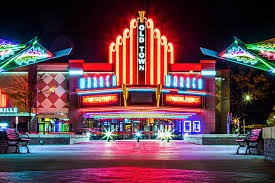
- Indoor
The Wichita area is home to numerous indoor theaters. Here's a sampling:
- The Warren Theaters (movie)
Generally Wichita's largest and most spectacular multi-screen movie theaters, the Warren Theaters offer moviegoers a feast of options -- with three huge theater complexes -- in Old Town (on 2nd St. by the tracks, west of Washington Ave.) and in northeast and northwest Wichita -- ranging from five screens to more than a dozen -- some utterly huge. At the Warren Old Town, for instance, a giant IMAX screen is matched by luxurious seating that includes built-in small tables, with wide aisles allowing waiters to serve you food as you await the movie. East and West theaters include an affordable coffee shop, for an extended family outing, or a date night. Lavishly decorated in modernized Art Deco, the interiors, alone, are a feast for the eyes.

-
The Orpheum
One of the last great movie palaces of the 1920s, the enormous Orpheum (shown at right, and below), at the corner of First and Broadway, is in continuous, loving restoration -- and available for all kinds of events. For those who have never seen a grand, old-fashioned movie palace, this is a must-see. Occasional national acts perform music and theater, while others use it for local performers, corporate events and personal parties. The interior, done as a Spanish Villa, richly trimmed with ornate carvings, and a towering vaulted ceiling -- can accommodate several hundred people, at least, on both the grand floor and a massive balcony. The huge stage, with its two-story-high curtains, can accommodate almost any kind of performance, as well as movie, video and live-TV projections.
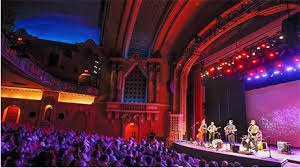
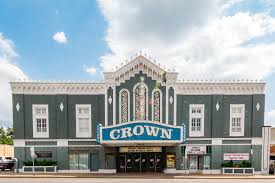
-
Crown-Uptown Dinner Theater
Another of Wichta's beloved movie palaces saved from the wrecking ball, the Crown-Uptown (shown at right and below), on East Douglas Ave., immediately east of Hillside Ave., is home to lively dinner theater performances of popular plays (particulary comedies and musicals). Before the show, at intermission, and after, the cast does double-duty, greeting guests and waiting tables. Fine dining and a show, under the "sky" (in any weather) at a substantial -- but not overwhelming -- price.
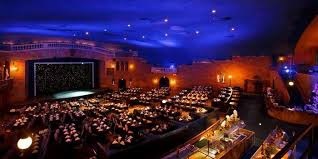
-
Kechi Playhouse
 Situated north of the city, in the quirky suburb of Kechi, at the corner of Oliver and 61st St., the compact brick playhouse (once a church), has become a traditional magnet for local stage performers, and provides close-up, intimate performances of plays and musicals ranging from Shakespeare to modern drama to slap-stick comedy. In season, it is one of the bargain entertainments in the Wichita area -- a popular, cheap and pleasant way to sample local live stage performances.
Situated north of the city, in the quirky suburb of Kechi, at the corner of Oliver and 61st St., the compact brick playhouse (once a church), has become a traditional magnet for local stage performers, and provides close-up, intimate performances of plays and musicals ranging from Shakespeare to modern drama to slap-stick comedy. In season, it is one of the bargain entertainments in the Wichita area -- a popular, cheap and pleasant way to sample local live stage performances.
- Integral Theaters & Auditoriums
Numerous buildings and facilities around Wichita house theaters or auditoriaums within them -- many available for rent to outsiders. Colleges, schools (particularly Wichita Public Schools' high-school and middle-school auditoriums), churches, clubs and even some businesses have substantial theaters and/or auditoriaums within their walls, many of which welcome and host public or personal events. Most can accomodate stage performances, and many can accommodate movies, video and live TV. Here's a sample:
-
Scottish Rite Temple
(at 1st & Topeka)
Inside Wichita's historic, castle-like Scottish Rite temple (a once-secretive Masonic Order facility), there is an elegant, antique, meeting hall / theater -- with three-story-high ceiling and ornate big stage, crowned with a towering-arch, overlooking a broad, flat, carpeted-floor audience space that accommodates chairs or dining-table seating for dozens, or hundreds. Once the exclusive turf of the Scottish Rite Masonic Order, now available for rent to the public, and an exceptionally elegant site for corporate and civic events (though parking is a bit of a challenge).
-
20th Century Club
At the corner of Broadway and Elm (just north of Central) this politely elegant, antique meeting hall -- built for upper-class Wichita women of the early 20th Century -- includes both reception and meeting rooms, and a surprisingly compact-but-substantial theater, wtih close-up, two-level seating for well over a hundred people, facing a broad, high-ceiling stage (which also accommodates movies & video). Popular as a venue for political gatherings, it is, at once, both "charming" and mildly "impressive." Conspicuous location, with easy access, and usually-adequate adjacent parking.

-
Wichita State University:
WSU, in northeast Wichita -- stretching between 17th and 21s Streets, and east from Hillside -- is richly endowed with multiple theaters and auditoriums, mostly used for university and student organization events, but also for rent to the public. Quality, accommodations & parking vary widely. Here are some principal WSU auditoriums and theaters. All are on the southwest area of campus (lower-left side of the map) :
-
Wilner Auditorium
Wichita State University's aging Wilner Auditorium -- at WSU's southwest corner, on the west side of the grand entrance to WSU (at 17th and Fairmount) -- is home to WSU's theater school, and provides an extraordinarily broad stage, and audience accommodation for several hundred, or more. Generally poorly maintained by the University, its age usually shows. Chiefly a venue for various university performances and programs. Parking is difficult, and mostly far from the building. The university offers few amenities within the theater, though a reception hall adjoins the theater lobby.
-
Dirksen Fine Arts Center ("D-FAC")
Auditorium / Concert Hall
On the west edge of WSU, home to the WSU School of Music, and a couple of generations more modern than the nearby Wilner Auditorium, the D-FAC includes a huge auditorium seating several hundred to a few thousand, in classic theater seating, in front of a massive, broad stage -- particularly used by WSU's music groups, including its substantial orchestra and chorus. Also used for various convocations, guest speakers and other events. The massive lobby-hall allows for a variety of activity connected with the auditorium's events. Parking, about 50-100 yards away to the west is more than adequate for most events. "Necessary facilities" are adequate and appropriate.
-
Wiedeman [Concert] Hall
Immediately north of the D-FAC is Wiedeman Hall, a 400-seat concert hall, designed around its massive Danish Marcussen pipe organ (first on the continent). Newest venue at WSU, with "great acoustics," it is primarily used for WSU School of Music recitals and concerts, also used by prominent organists for recitals and recording.
-
RSC Theater
(at the Rhatigan Student Center)
RSC Theater is adjacent to the RSC (Rhatigan Student Center), itself. The RSC (known to old-timers as the "C-A-C": Campus Activities Center) is the principal "student union" gathering hub of the university (bookstore, student club offices, student lounge, recreation area, ballroom, dining and vendors). The RSC Theater is "right next door" to the RSC's west side, in a "plain brick box." The modest-but-substantial theater offers seating for hundreds, and a stage that accommodates just about any common activity, including movies (which are normally shown here, weekly, during the fall and spring semesters).
Seating is adequately comfortable, and events here (particulary movies) have traditoinally been fairly cheap (though skyrocketing college costs, and the rapidly increasing commercialization of WSU, probably are driving RSC Theater prices skyward, now). While the theater has a substantial lobby, refreshments are not always available, and must often be acquired from the adjoining RSC, itself -- which is not always open.

-
Friends University Auditorium
In elegant, old, towering Davis Hall, the centerpiece of Friends University (near Meridian and West Kellogg/US-54), an aging, creaky-floored, old auditorium accommodates several hundred in relative comfort, with an antique ambiance, excellent view of the stage, but poor acoustics. Used for a wide variety of educational presentations, entertainments and community events -- including political debates. Parking is sometimes adquate, and not far away. However, the building is arranged so that climbing stairs is the most practical way, for most visitors, to this second-story facility. Entering the auditorium during programs-in-progress is awkward, as it generally requires entering from a door on either side of the stage, which isn't ideal, nor inconspicuous. Minimal accommodations in the lobby/hall.
-
Century II
Concert Hall & Mary Jane Teall Theater
(West Douglas, at the River)
These two separate-but-adjoining "slices" -- of the pie-shaped Century II Civic Center complex -- are home to the Wichita Symphony Orchestra and local stage performances. The Concert Hall seats 2,000+; the Mary Jane Teall Theater (specialized for stage performances) seats 600+. Compared to other Wichita venues, the interiors are strangely bland, with uninspring acoustics and lighting, and modest-but-adequate audience accommodations. They are major elements of the Century II complex, but hardly inspiring (nothing visible to distract the audience from the performers). Parking is either plentiful and fairly close, or extremely challenging --
depending on whether other events are going on in other parts of the Century II complex.
For more on the Century II Civic Center,
CLICK HERE.

-
Century II
Exhibition Hall
(West Douglas, at the River)
This largest section of the pie-shaped Century II Civic Center -- far more popular and widely used as a venue than the smaller Theater / Concert Hall -- offers a massive stage, and provides combined floor, bleacher and balcony seating for 3,000 people. The entire space can be opened for exhibitions, trade shows, and other events. The bleachers can be moved aside for chairs and/or dining tables. Many spectacular events take place here, from rock and country/western concerts, to car shows and high-tech trade shows, to the dazzling annual Asian Arts Festival. One of the most flexible and valuable venues in Kansas. Parking is either plentiful and fairly close, or extremely challenging -- depending on whether other events are going on in other parts of the Century II complex (though events in the Exhibition Hall usually take precedence).
For more on the Century II Civic Center,
CLICK HERE.
-
Exploration Place Theaters
(McClean Blvd., north of 2nd St.)
Two main venues are imbedded in the fantastic
Exploration Place
interactive science museum:
-
EP's IMAX Dome Theater
A spectacular IMAX sky-dome theater/planetarium for a few hundred.
it is used for planetarium shows, science films, and spectacular whole-dome IMAX movies that surround and wrap the viewer "inside" the movie. An IMAX dome movie is a must-see experience, if pricey.
Other accommodations adequate, but pricey. Adjacent free parking usually adequate.
NOTE: Although other area theaters also show "IMAX" films -- they're not dome theaters (which surround you). However, another, even-bigger IMAX dome is available at the spectacular Kansas Cosmosphere space museum, in Hutchinson, a hour's drive away.
-
EP's Auditorium
A simple-but-adequate theater / auditorium for a few hundred, with somewhat steep seating providing good acoustics for presentations and movies/videos/live TV. Imbedded in
Exploration Place.
Occasionally used for community and corporate events.
Adjacent parking usually adequate. Other accommodations adequate, but pricey.
-
County Courthouse Jury Room
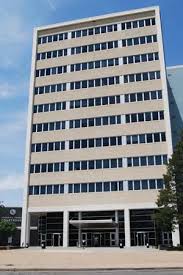 For some bizaare reason, a large number of civic and organization events are conducted here, including some important political events. The main building, the (newer) County Courthouse, itself -- downtown, at the northeast corner of Central and Main-- is conspicuous and well-known. However, the main entrance to the Jury Room -- on the north side of an extension to the building, next to the jail's squad-car entrance, is an obscure location, which some would-be attendees never find.
For some bizaare reason, a large number of civic and organization events are conducted here, including some important political events. The main building, the (newer) County Courthouse, itself -- downtown, at the northeast corner of Central and Main-- is conspicuous and well-known. However, the main entrance to the Jury Room -- on the north side of an extension to the building, next to the jail's squad-car entrance, is an obscure location, which some would-be attendees never find.
Metered parking is in the county garage across the street, or on the street, and virtually no parking is available during daytime events, owing to the huge amount of traffic for courthouse activity. Evening events are more accessible, but the place is harder to find in the dark (some go to the Courthouse main entrance, find it locked, and just go away).
As a venue, can accommodate a few hundred -- but folks in the back, and on the sides, must stand, and peer around various columns blocking their view. Vending machines and bathrooms provide barely adequate accommodation, but the tidy facility is, nevertheless, claustrophobic and generally unpleasant. A truly crummy venue, not appropriate for much of anything. "Free" would be overpriced.
-
Wichita Public Library - Main Branch
(2nd & McClean Blvd.)
Adjoining the entrance to the new Main Library (which is just north of the Delano District, immeidately acorss the river from downtown). The new auditorium lacks the simple elegance and warmth (and accessibility) of the prior library auditorium downtown (once a very popular, affordable venue for numerous small local events), and the new place is surprisingly small for the pivotal role that it was apparently intended to play in community events (various events have filled the small new auditorium, forcing many, perhaps most, of the arrivals to be turned away). Gray and gloomy. Parking is a battle -- and many can be turned away by a full parking lot, with no alternative for blocks around. Predatory pricing of refreshments, occasionally available in the cold, stark lobby, adds to the discomfort. Not recommended.
- Outdoor Theaters & Amphiheaters
-
Pawnee Drive-In Movie Theater
Wichita is one of the few mid-sized cities in America that still has a functoining drive-in movie theater -- though it nearly wasn't so.
While Wichita was once home to numerous drive-in theaters (81, K-42, Meadowlark & Twin, among them), all had closed down by 2017 -- the last holdout being the big-screen Pawnee Theater, on the southeast outskirts of town, at Hydraulic and MacArthur -- which closed, amid dwindling attendance, in the early 2000s. Its essential projector system was sold off for a pittance, and the rest of the facility left to rust.
When a developer petitioned the city to demolish the facility, to erect another land development, the community suddenly erupted in opposition to losing the community's last hope of a drive-in theater, and a frenzied popular movement -- to save, restore and revitalize the theater -- materialized out of nearly thin air (aided by local media and a bank). The City Council -- initially favoring the proposed demolition and redevelopment -- responded to the emotional community outcry, and joined in the theater restoration, putting up money to help recover the projection equiplment, and restore the theater. By the summer of 2019, the theater was back in operation.
-
Dirksen Fine Arts Center
("D-FAC") Amphitheater:
at Wichita State University
On the western edge of Wichita State University, the slightly modernistic brick Dirksen Fine Arts Center ("D-FAC") is home to the WSU School of Music. In addition to its large indoor auditorium / concert hall, it has a sizeable outdoor stage, as well, facing a bowl-shaped plot of land, designed to serve as an amphitheater, to permit casual lounging in the grass to listen to fair-weather concerts (chiefly by university performers). Not as frequently used as when it was new, the site nevertheless is an occasoinal venue, and can accomodate over a thousand -- though "necessary facilities" are not conveniently located, and public access can be awkward.
-
Linwood Park Shelter & Stage
One of Wichita's oldest and most picturesque parks, the northern half of Linwood Park (immediatly north of Harry St., just east of Hydraulic Ave.) has a big stone-and-timber park shelter, with a stage projecting to the south, facing rows of park benches accommodating hundreds. Available for inexpensive rent, through the City of Wichita Park Dept., it is used for numerous minor events. Very occasionally (compared to its heydey) free concerts are performed for the public there. "Necessary facilities" are a substanial hike, over 50 yards away, and the limited parking is even farther away.
-
Riverside Park Shelter & Stage
Comparable to the Linwood Park Shelter (above) -- with parking more of a challenge, but a more central and conspicuous location (visible from Nims Blvd. which passes through te center of Riverside Park, between Central and 13th, just east of Seneca, and obvious to drivers on the other roads tbrough the park).
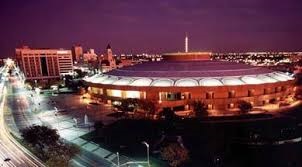
-
Century II Plaza
The large concrete apron spreading out from the north side of Century II Civic Center (above), is a popular seat-less outdoor theater space for outdoor concerts. The local orchestra, and various bands, occasionally use the roof-sheltered steps of Century II as the stage -- particularly during RiverFest and Fourth of July celebrations. However the plaza slopes down away from the stage, creating a rather poor acoustic and visual accommodation for all but those near the stage (steps).
- Hotel convention facilities:
Wichita has several large hotels with extensive convention/meeting facilities, generally including restaurant (with on-site catering), bar/club, pool, numerous meeting rooms
 (from very small conference rooms to large banquet halls, often accommodating hundreds). Hospitality accommodations usually include a wide range of hotel rooms (including executive suites), indoor pool, courtesy car, and other amenities.
(from very small conference rooms to large banquet halls, often accommodating hundreds). Hospitality accommodations usually include a wide range of hotel rooms (including executive suites), indoor pool, courtesy car, and other amenities.
- Hyatt Regency (West side of Downtown, on the river, at Waterman): South of (and attached to) the Century II Civic Center, it is the city's primary hotel and convention complex, large, modern and airy -- though requiring a lot of walking. It is connected, on the 2nd floor, to the south building of the Century II complex, permitting sharing of facilities, by arrangement. Adjacent parking garage, and large civic parking lots (some free), with extensive indoor facilities, restaurant, and club, with on-site catering. Most rooms have a fairly scenic river-and-downtown view.
- Drury/Broadview
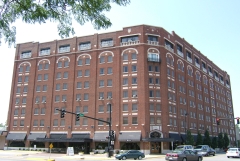 (West side of Downtown, on the river, at Douglas and Waco):
Across Douglas Ave. from the Century II Civic Center, it is the city's most elegant old hotel and convention complex, exceptionally comfortable, beautifully restored and redecorated in recent years. Limited parking (though a large, free parking lot and parking garage are a half-block north), but very extensive indoor facilities (including a massive ballroom / convention hall), and a fine restaurant. Next to the river, in easy walking distance of the cozy Delano shopping district west of downtown, and a short (free) trolley bus ride to the nightlife district in Old Town, east of downtown. As with most old hotels, rooms are generally small -- though most rooms are attractive and comfortable (most with a nice river or downtown view) and a few large suites are available. Apparently popular with mid-sized convention groups for on-site events, and large convention groups using the Century II Convention Center, across the street.
(West side of Downtown, on the river, at Douglas and Waco):
Across Douglas Ave. from the Century II Civic Center, it is the city's most elegant old hotel and convention complex, exceptionally comfortable, beautifully restored and redecorated in recent years. Limited parking (though a large, free parking lot and parking garage are a half-block north), but very extensive indoor facilities (including a massive ballroom / convention hall), and a fine restaurant. Next to the river, in easy walking distance of the cozy Delano shopping district west of downtown, and a short (free) trolley bus ride to the nightlife district in Old Town, east of downtown. As with most old hotels, rooms are generally small -- though most rooms are attractive and comfortable (most with a nice river or downtown view) and a few large suites are available. Apparently popular with mid-sized convention groups for on-site events, and large convention groups using the Century II Convention Center, across the street.
- Airport Hilton Inn: (West Wichita, at Wichita's Eisenhower Airport, just northwest of the terminal): Ample parking, extensive indoor facilities, elegant, expensive restaurant -- with extraordinary buffets -- and club. Far removed from all other commercial activity and resources.
- Marriott Inn: (Far East Wichita, just north of Kellogg at Webb Road, immediately across from Textron's Beech Field) A large hotel, immediately surrounded by several lower-cost motels, allowing many options for guest accommodations. Limited, but generally adequate, parking. Extensive convention facilities, restaurant; small, part-time gift shop /convenience store. Far removed from all other commercial activity and resources.
- Motel convention/meeting facilities:
Smaller, less-expensive convention facilities are available at large motel complexes on major highways, with easy access and extensive parking.
Two particularly popular such facilities, with restaurant, meeting rooms, and other accommodations are:
- Red Coach Inn / Best Western Airport Inn & Conference Center (6815 W. Kellogg Drive, southeast of Kellogg and Ridge Rd., a mile west of I-235, a mile or two from airport terminal.):
A large, comfortable facility, moderately priced, with large non-private meeting area (surrounded by hotel rooms, under a giant roof), and smaller meeting/dining hall(s) and other spaces. Good, affordable restaurant. Extensive shopping (pricey and affordable), other restaurants, and fast-food, all available within a mile, 24 hours a day. Business center, indoor courtyard and pool, putting green.
- Best Western North Wichita Hotel & Suites (North of the city, at 915 E. 53rd St. North, west of I-135 and 53rd St. interchange) :
A large, comfortable facility, moderately priced, with large non-private meeting area (surrounded by hotel rooms, under a giant roof), and smaller meeting/dining hall(s) and other spaces. Good, affordable restaurant. Adjacent truck stop / convenience store, and nearby fast-food places.
PARKS:
Wichita has a substantial array of public parks, particularly in the older parts of the city (developers now frown on requirements to set aside sections of land for public recreation -- and developers' interests generally dominate Wichita city government).
Though small parks often have little or no amenities, most parks have one or more of these: playground equipment, baseball diamonds and/or other sports spaces, picnic tables (sometimes with cooking grills or fire pits), and/or public restrooms. Several have community centers, club houses and/or open park shelters (use may require reservation and/or rental arrangements with the city's Parks & Recreation Dept.). Some have a branch library.
The City's Evolving Pools Policy:
|
A few have a water playground -- either an attended, fee-charged swimming pool, or unattended, free "splash pad" with "interactive fountains." While encouraging the development of costly, semi-commercial private YMCA pools, the city is shutting down most public swimming pools -- especially in poor and minority neighborhoods -- replacing them with cheap, unattended "splash pads" for little kids to run around in various water sprays (teens and adults are deprived of any real water entertainment in those places.).
WICHITA'S MAIN PARKS:
FAR-NORTHWEST:
- Sedgwick County Park
An extensive public park, about a half-mile east of Ridge Road, stretched between 21st St. North and 13th St. North (the only two access routes), behind the Sedgwick County Zoo (which, itself, is just west of the Big Ditch and Zoo Boulevard).
Large "nature park" around a sand lake, with many trails and paved walkways. Developed and maintained by the Sedgwick County government, rather than the City of Wichita, it is one of the community's principal parks, and one of the few largely-natural parks in Wichita -- with nearly a half-square-mile of winding roads, trails, creeks and ponds, tall trees and small woods. A few open spaces are popular venues for various events, from small weddings to the big annual Rennaisance Fair.
- Evergreen Park (north-northwest Wichita, at 25th and Arkansas, a mile west of Broadway). Small park with pool, large clubhouse, and Evergreen Branch library. Located in one of Wichita's most-Hispanic districts.UPDATE Oct.2019: The City Council voted to close this park's pool, replacing it with a much cheaper "splash pad."
NORTHWEST:

- Riverside Park and adjoining Oak Park (just northwest of Downtown, along the banks of the Little Arkansas River). Wichita's oldest, and one of its largest and best park spaces. Along the tree-lined banks of the rivers, the sprawling pair of parks offer
shaded riverbanks, woods, public restrooms, and picnic tables (though
 many prefer lounging and picnicking on blankets
on the shady slopes along the riverbank).
many prefer lounging and picnicking on blankets
on the shady slopes along the riverbank).
(Oak Park riverbank, however, is a hazardous stroll, because it is also a "disc-golf" course, with Frisbees flying fast, without warning).
Central section of Riverside Park includes petting zoo, playground equpipment, and large open-air park shelter / band stage. South portion of park includes seasonal, attended, fee-charged tennis courts (which replaced the city's largest swimming pool in the 1970s after the park became popular with African-American Wichitans).
(NOTE:
For the full "Riverside experience," snack at artsy, cozy "Riverside Perk" coffee shop, at 11th and Nims, just north of the park -- or farther north on Nims, at 13th Street, at the nostalgic Riverside Cafe.)
- Sim Park / Oak Park (west of Riverside Park, south of Botanica, Oak park provides a scenic tree-rich (and tick-rich)
 woods. Farther west, Sim Park, along the east banks of the Big Arkansas River, provides wooded sand hills covered in trees, with shaded clearings equipped with picnic tables and fire pits. Trails through the woods. Fun exploring for kids. Steep riverbanks lead to sand bar on the river. Beware of ticks in the woods, and sand burrs in the grass.
woods. Farther west, Sim Park, along the east banks of the Big Arkansas River, provides wooded sand hills covered in trees, with shaded clearings equipped with picnic tables and fire pits. Trails through the woods. Fun exploring for kids. Steep riverbanks lead to sand bar on the river. Beware of ticks in the woods, and sand burrs in the grass.
- Bontanica (west-northwest Wichita, on Murdock between the rivers, north of Cowtown and the Wichita Art Museum.) Botanica is a "hidden" botanical garden with many paved walkways and trails. Admission is charged. Very large clubhouse and visitor center. Used for many events, from weddings and private parties to large business and social events. Guided tours of the gardens are available. Seasonal.
- Minisa Park (northwest Wichita, on the west bank of the Little Arkansas River, just west of North High School, on 13th). Small park with popular clubhouse and pool. UPDATE Oct.2019: The City Council voted to keep and renovate this park's pool.
DOWNTOWN:
Wichita has eight "sort of" parks downtown -- most quite small (some no bigger than the footprint of a demolished office building). All suffer from urban noise, though most are an escape from the full volume of downtown noise. Few have adequate nearby parking, and most have no restrooms or other facilities, severely limiting their usefulness to the public. The presence of skateboarders and the homeless often diminishes their appeal to some people, and downtown developers are always trying to encroach upon, and confiscate, these few remaining "nice" spots in downtown:
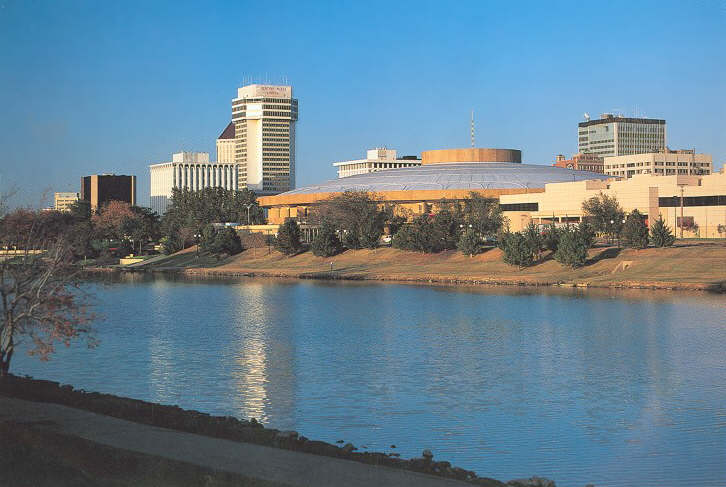
- The Arkansas River Bank
The East and West banks of the Arkansas River, throughout downtown and beyond, constitute the one of the very largest continuous park spaces in Wichita, and one of the longest "clean" riverbanks in any mid-western city.
Once cluttered, polluted with adjacent industries, and unsafe, the riverbanks were cleared and largely restored to natural (but trimmed and mowed) condition -- with added footpaths and bikeways -- during the 1960s and 1970s renovations of the river corridor, in concert with the development of the
Century II Civic Center.
 The entire West Bank of the Arkansas River -- from the MacArthur Bridge on South Broadway, north to the confluence of the Little and Big Arkansas rivers near Riverside Park -- was cleared, cleaned-up, and "beautified" with trees, walkways and bikepaths.
The entire West Bank of the Arkansas River -- from the MacArthur Bridge on South Broadway, north to the confluence of the Little and Big Arkansas rivers near Riverside Park -- was cleared, cleaned-up, and "beautified" with trees, walkways and bikepaths.
Much the same was done with the East Bank, as well, although some business and other structures complicated the renovation -- particularly...
- the Century II Civic Center, itself,
- a riverbank petrochemical factory immediately south of Kellogg,
- the historic Broadview Hotel north of Douglas,
...and the competition for the East riverbank from:
- a church,
and (especially)
- the development of large office buildings and apartment complexes being built north of the Broadview all the way to the confluence of the rivers, and beyond.
Nevertheless, much of the East Bank of the river remained (or was restored to) open space, as was nearly all of the West Bank -- creating a spectacular scenic vista through the heart of the city (enjoyable even from inside an automobile cruising the riverside drive -- McClean Boulevard), a vast new liesure space for the community, instituting the city's first substantial "bike paths," and greatly facilitating the development of the city's biggest national attraction: its annual RiverFest.

- Keeper of the Plains Park
...at the north end of the Arkansas River, on the penisula at the confluence of the Big and Little Arkansas Rivers, behind the Mid-America All Indian Center. Its iconic towering "Keeper of the Plains" Native American statue, perched on a pillar of giant stones, and occassionally lit by a circle of fire pits, is the grand centerpiece of this tiny park. Bridges for foot and bike traffic link the park to the Exploration Place parking lot, to the south, and -- to the north -- the southern edge of Riverside Park.
- A. Price Woodard Park
-- behind the
Century II Civic Center, on the East Bank of the Arkansas River ("a park within a park")-- is a small garden-and-waterfall riverside space, with modern walkways and viewpoints, providing a pleasant, below-the-traffic wandering area. Popular with West Downtown workers as a brownbag-lunch spot, it's also a popular playspace for the young, and a casual spot for romantic walks, extending out onto the walkway/bikepaths going up and down the river.
- Century Plaza Park,
on the West side of the Century Plaza office building on the southwest corner of Douglas and Main. A small square concrete well, about a quarter-block in size, below street level, with waterfalls, and winding stairs -- a small out-of-reality escape for downtowners, and (especially during evenings and weekends) everyone else. Especially popular on hot summer days.
-
Chester I. Lewis Reflection Park
a.k.a.
"Lunch Counter Plaza",
on the south side of Douglas, halfway between Market and Broadway, a concrete plaza with lunch tables and extensive artwork, including large bronze sculptures -- particularly
a large re-creation of the once-nearby Rexall Drug Store lunch counter
(scene of
America's first "lunch counter sit-in," in 1958, to force desegregation of eating places). Named for the organizer of the sit-in, it ironically is not at the site of the actual Rexall drug store (which was a half-block east). but rather on the site of the city's last downtown-store lunch counter, in the Woolworth's department store, demolished in the 1980s.
The park is used, lightly, by downtowners and downtown visitors, chiefly as a lunch-break hangout.
The Naftzger Park Saga:
Originally, Naftzger Park was a half-block of peaceful, secluded scenic green space, furnished in 1890s trim, with park benches and a gazebo, surrounded by an ornamental wrought-iron-and-brick wall, providing a comparatively quiet space neatly shielded from traffic and some of downtown's noise. It quickly became a popular brown-bag lunch refuge for downtown workers and visitors.
It also became popular for homeless people, who often made up most of the park population. But most of the community seemed to find a comfortable, peaceful co-existence with the destitute, and the park remained generally popular.
With the the rash of downtown development since 2010, downtown property developers inevitably cast their avaricious eyes upon the last remaining attractive open space in East Downtown.
Under pressure from local businesses and developers (and a few who hated the vagrants) -- and despite strong community opposition -- the City Council essentially demolished the park, and replaced it with an open area for thru-traffic (scooter, bicycle and pedestrian), to accommodate the area's business traffic.
And, eventually (late 2019),
part of the "public" space was turned over to commercial businesses.
Now the Naftzger "park" is more of a commercialized eyesore, typical of Wichita downtown development, and no longer even slightly a "peaceful, secluded" downtown environment for the public.
See:
-
Wichita rents out park land for restaurants' outdoor dining.
2019-10-01 Wichita Eagle
-
Wichita's downtown development continues with Naftzger Park redesign.
2019-10-03 KSAS-TV (Fox)
|
- Naftzger Park
On the south side of Douglas at the east edge of downtown, nestled against the train tracks. The only true "park" in downtown Wichita, for many years. Now stripped of its secluded English-garden charm and turned into a commercial space, with snippets of flat, open public space. (See "Naftzger Park Saga" at right.)
- Skateboard space
- under West Kellogg Overpass
-- west of Main St..
OK, this is actually a usually-empty city parking lot. But skateboarders seem to have found a use for it -- much more than the rest of the community.
- Skateboard park
- under East Kellogg Overpass
-- east of Emporia.
A true (if tiny) skateboard park, with undulating and curved concrete structures designed to provide true entertainment for skateboarders.
SOUTH:
- O.J. Watson Park (southwest Wichita, on McClean Boulevard two blocks north of 31st Street South, approximately a half-mile west of Broadway). One of the city's favorite parks. Large tree-filled park surrounding winding lake (no swimming or personal boats allowed), with fishing, many picnic tables, open-air park shelters. In peak seasons (at certain times), the park offers paddle-boat rentals, chlidrens' pony rides, and a miniature train -- all available for moderate fees.
SOUTHEAST:
- College Hill Park (south of Douglas Ave., east of Rutan, nestled in the upscale "College Hill" neighborhood.) One of the city's nicer, more secluded, parks -- and one of the few with rolling hills and valleys -- College Hill park has been a Wichita favorite for most of the city's history. Situated in a valley, and richly endowed with trees, it is one of the few Wichita parks not thoroughly battered by the notorious Kansas wind. The only space connecting to a major street is the northern border, where a slice of the park touches Douglas Ave., at the crest of a slope popular for sledding in the winter. The park includes charming footpaths and children's playground, along with a small swimming pool. UPDATE Oct.2019: Rather than replacing it with a much cheaper "splash pad" (as the City is doing to several other parks), the City Council voted to keep and renovate this park's pool.
- Linwood Park (inner-southeast Wichita, two miles southeast of Downtown, between Hydraulic and the Canal Route, between Lincoln and Mt. Vernon). One of the city's oldest, largest and most beautiful parks, it stretches for nearly a mile from Mount Vernon, north across Harry St., which splits the park in two.
-
South half (south of Harry St., along Hydraulic Ave.) includes Linwood Branch public library & community center, public pool, baseball diamonds and other sports spaces. Also site of a school. UPDATE Oct.2019: The City Council voted to close this park's pool, replacing it with a much cheaper "splash pad."
-
North half (north of Harry, hidden a block east of Hydraulic) is richly covered in trees, with gentle hill-slopes, a large open-air park shelter / band stage, picnic tables, playground, and public restrooms.
- Boston Park (between Harry St. and Lincoln, along Woodlawn Ave.) Rather bland, nearly-treeless park includes an extensively furnished skateboarding park, and a swimming pool. UPDATE Oct.2019: The City Council voted to close this park's pool, replacing it with a much cheaper "splash pad."
- Planeview Park (along the southwest side of George Washington Boulevard, between Pawnee and 31st St. South). Baseball diamond; long, open walkways / bikepaths; modest accommodations in a park that serves the city's most notoriously impoverished district. The park is separated from most of the Planeview neighborhood by the Kansas Turnpike, with a single narrow bridge arching over it to connect the park with its "neighborhood." Another oddity is a large man-made hill, with a strip of roadway over it, used for "Soap Box Derby" races. UPDATE Oct.2019: When deciding which parks would keep pools, and which would get cheaper "splash pads," the City Council voted to provide this park with a "splash pad."
NORTHEAST:
- McAdams Park (north-central Wichita, just west of the Canal Route, between 13th and 17th). Includes baseball diamonds and other sports spaces, public restrooms. Also site of a school. The pool there has been closed for years, and there has been a recent controversy by the city over plans to demolish it, over stiff community objections. UPDATE Oct.2019: Under intense public pressure, the City Council voted to keep and renovate this park's pool — rather than closing it, demolishing it, and replacing it with a much cheaper "splash pad," as they had originally intended.
- Fairmount Park (two blocks south of the East side of Wichita State University) includes a clubhouse, water-spray pad, and public restrooms. This park's pool was closed over a decade ago, and the city replaced it with a much cheaper "splash pad."
- Edgemoor Park (northeast Wichita, at 9th and Edgemoor). Targeted at the upper-income neighborhood east of it. Includes Edgemoor Branch Library, large clubhouse, and swimming pool (which has increasingly attracted many from the poorer neighborhoods to the west). UPDATE Oct.2019: The City Council voted to close this park's pool, replacing it with a much cheaper "splash pad."
OTHER PARKS:
Numerous other small neighborhood and Downtown parks dot the city -- 144 in all -- many with clubhouses, shelters, water parks, sports spaces, or other recreational facilities (though many have little or no accommodations, and some are largely barren open ground).
Special parks include an equestrian (horseback riding) park (Pawnee Prairie, in far west Wichita), a few "dog parks" (the city plans a dozen more), skateboard parks (particularly under each end of the downtown Kellogg Overpass), and a park to fly model aircraft and drones.
For more information on Wichita-area parks, see the Wichita Parks Recreation and Open Space Plan - Plan Update 2016 on the city's website.
SPORTS COMPLEXES:
PUBLIC:
In addition to the sports facilities at the regular parks, Wichita has two large public sports complexes specifically designed for sporting events and activities. Their use may require fees and/or reservations. Contact the City of Wichita Parks & Recreation Dept..:
- East Side Athletic Field (far northeast outskirts of Wichita, on Greewich Road, north of K-96) Extensive baseball diamonds and other sports spaces, with bleachers and public restrooms.
- West Side Athletic Field (inner-northwest Wichita, on McClean Boulevard, a half-mile west of Seneca) Extensive baseball diamonds and other sports spaces, with bleachers and public restrooms.
PRIVATE:
- Westurban Baseball Field (far-northwest Wichita, on Ridge Road, north of 13th)
A private youth baseball (not softball) complex that is owned and operated by a non-profit organization, which has its own league focused solely on youth baseball. Home also to the Greater Wichita Athletic League Baseball Program, various independent schools and Walter Johnson Semi-Pro Teams, and site of various youth baseball tournaments. The complex has 11 diamonds -- some sized for younger players, and some with bleachers -- with restrooms and "a full service concession and lobby," spread over nearly 40 acres on the southwest corner of of Sedgwick County Park. See their officlal website: www.thebestplaywest.com
- YMCA sites
The YMCA is a "non-profit," but costly, private "heath club" -- with multiple sites around Wichita, including Downtown (partially financed by the City). The "Y's" generally include a gymnasium (particularly weight-lifting rooms), large indoor swimming pool (and some also have outdoor water parks or pools), basketball courts (some indoor), and various other recreational / athletic facilities, along with liesure resting places, locker rooms with showers, and some form of refreshment resources. Increasingly, the City Council has favored development of these costly private recreational sites over the City itself developing such facilities free to the public. Critics argue that this shift away from free public recreation is a move towards reinstating economic and racial segregation in community recreation.
- Genesis Health Clubs
Another costly private "health club" network, with large sites throughout the city.
GOLF COURSES:
Wichita has several large, attractive public golf courses, spread around the city. They are not free. For more on them, contact the city's Parks & Recreation Dept. Three private golf courses are reserved for the wealthy, at the community's private "country clubs": Rolling Hills (in far-west Wichita), and Crestview and Terradyne in far-east Wichita).
Local amuseument parks (see below) commonly include driving ranges and miniature golf courses.
AMUSEMENT PARKS & FACILITIES:
Though once well-stocked with amuseument parks, Wichita has little to offer in the way of amusement parks today. These modest, but entertaining, sites remain:
-
All Star Sports East -- (far east Wichita, on Webb Road, between Central and 13th Street North). Go karts, miniature golf, driving range, batting cage, arcade.
- All Star Sports West -- (far west Wichita, on 13th Street, east of Tyler Road). Go karts, miniature golf, arcade, etc..
- Various skating rinks -- both ice skating and roller skating (a handful of skating rinks remain), particularly:
- Wichita Ice Arena -- (across the river from downtown Wichita, on Lewis/Maple Street, just west of the river and McClean Boulevard). Ice skating; classes available.
- Bowling alleys -- Wichita is still enthusiastic about bowling (WSU's team wins collegiate championships), and several bowling alleys -- small and large -- are scattered throughout the city.
- Museums & Libraries -- Wichita has numerous libaries and museums (see the EDUCATION section, above) -- particularly in the heart of town -- and some are entertaining (part-time or continuously). In particular, these two sites are aimed at providing dynamic family entertainment:
- Cowtown Museum:
 Exceptionally authentic recreation of early Wichita -- with many of its original buildings. Character re-enactors, in authentic garb, portray pioneer Wichitans, including cowboys and farmers, a blacksmith, bartender, storekeeper, gentle ladies and saloon gals, and more. Shootouts may happen on short notice. Educational & fun, and a true-to-life disconnect from the modern world. Seasonal.
Exceptionally authentic recreation of early Wichita -- with many of its original buildings. Character re-enactors, in authentic garb, portray pioneer Wichitans, including cowboys and farmers, a blacksmith, bartender, storekeeper, gentle ladies and saloon gals, and more. Shootouts may happen on short notice. Educational & fun, and a true-to-life disconnect from the modern world. Seasonal.
- Exploration Place:
(On the west bank of the river, immediately northwest of Downtown, on McClean Boulevard. Odd-looking gray concrete building with sweeping curves.) Exciting, interactive science-and-technology museum, includes many hands-on activities for young and old. Includes such exceptional features as flight simulators and interactive wind-tunnels, planetarium and IMAX dome theater. VERY expensive, but you won't regret it. Come early, stay a long time. Do everythig. Kids will LOVE it.
ONCE UPON A TIME... Wichita used to be richly endowed with these grand amusement parks, all now closed:
-
Wonderland -- (on Ackerman Island, in the Arkansas River, downtown Wichita). A sandbar that formed in the Arkansas River in the 1870s became the 56-acre Ackerman Island -- by the early 1900s, site of Wichita's first substantial amuseument park, Wonderland. Declined by late 1920s, then closed, with only the ballpark active well into the 1930s. To counter flooding, federal Works Progress Administration ("WPA") recommended widening the river. To do so, the island was moved against the west bank, and largely eliminated, widening the main channel.
(See:
- Joyland -- (southeast Wichita, on Hillside south of Pawnee, near Planeview; 2801 South Hillside). Famed for its carnival atmosphere, huge roller-coaster, ferris wheel and countless other amuseument rides (including minature steam train made by local Ottaway Amusements), swimming pool, and picnic grounds -- for decades it was THE place for family fun, and couples' dates. Throughout much of Kansas, and even surrounding states, it is an iconic happy memory of childhoods, and coming-of-age, from the 1950s through the 1980s.
Faltering financially, it was idled in the 1980s, fell into ruin, and abandoned, and the remainder dismantled recently. The subject of a 2019 documentary on KPTS-TV.
(The "Churn & Burn" ice cream store has many Joyland signs & items, and Joyland's big signature carousel now restored, is at the Botanica aboretum, near Cowtown.)
See:
- " 75 years ago, Joyland opened in southeast Wichita" VIDEO, PHOTOS and TEXT
2024-06-12 - KSNW-TV
- "Joyland Amusement Park (Wichita, Kansas)", Wikipedia.
- "Joyland", Wichita Photo Archives
- "Joyland: A Once-Thriving Amusement Park That Now Sits Open To Looters", April 28, 2022, Abandoned Spaces.
- "Joyland Amusement Park of Wichita, Kansas", Facebook
- Kiddie Land -- (southeast Wichita, on East Harry between Oliver and Hillside). Miniature Joyland, in almost every respect, including more-modest roller-coasters, pools, rides. Miniature golf course. Prominent in the 1950s and 1960s. Destroyed to make room for the original Wichita Mall shopping center (now defunct). See:
- Frontierland: (Far West Kellogg / Highway 54, west of town; now only a few abandoned buildings remain, and the White Buffalo Antique Mall). A huge, authentic-looking Wild West town, with saloon/restaurant, Wild-West acts (shooters, rope & bullwhip experts, etc.), country/western music, stagecoach rides, archery range, bowling alley, ice skating rink, gift shop, occasional rodeos and horse-races, etc. Opened in 1961 coinciding with the Kansas Centennial. Closed in the 1960s, except for archery range and bowling alley, which closed in the 1970s. An antique mall now operates on the site. Now an EPA Superfund cleanup site, apparently contaminated by Vulcan Materials Co..
See:
- "Frontier Land U.S.A. Wichita Kansas vintage postcard Two Gun Avenue", Ebay
- " Frontier Land WPW - B 6 26 2020", VIDEO of POSTCARDS & PHOTOS, 2020, Wichita Postcard Club
- "Wichita Postcard of the Week", 2020-06-24, Wichita Postcard Club
- "Ice Skating Rink", POSTCARD of stagecoach, Mary Evans, Pinterest
- "Superfund site: Frontierland Park", Environmental Protection Agency
- Bridle & Saddle Club: (northeast Wichita, northeast corner of Central and Edgemoor; 5830 E. Central). A horse-ride stable and vast riding grounds, widely popular with Wichita families from the 1920s to the early 1980s, especially in the 1960s and early 1970s, teaching thousands of Wichita children to ride. From 1940, it was owned by the Bruce family, who operated it for generations. The last operator, Herb Bruce, sold the grounds when his widowed mother, Rose, retired at 93. Originally 75 acres, with a 12-mile riding path and 40 horses by 1926 (See: "Monday, September 13, 1926, page 5.", Wichita Eagle, summary in Tihen Notes, WSU), it was whittled down, over decades, by residential development and forced acquisition for government projects (school, National Guard armory, and Edgemoor Park). The final 33 acres were converted into Carriage Park shopping/dining center, peripheral commercial development, and housing. (See: "East-Side Horse Farm Sold to Developer", 1982-09-15 - Wichita Eagle)
- Barnacle Bill's / Fantasea (north of the city near Woodlawn at K-96) water park: huge pools, includng wave pool, giant water slides, etc. (See: "Fantasies of FantaSea: Many remember Wichita’s long-gone water park", 2017-05-09 - Wichita Eagle)
OLD TOWN:
Wichita's "party district" is the "Old Town" area across the tracks, to the east of Downtown, west of Washington Ave., from Douglas to 3rd Street North. Originally a warehouse district, the old buildings (many abandoned) found new life in the 1980s with the arrival of the monthly "Farm & Art Market," which stimulated the setting up of small shops, then eateries, and more.
Soon the district became the daytime playground of retirees, weekend playground of adults, and the late-night party town of the young. Includes large multi-screen movie theater (the Warren Theater), numerous cafes, bars and dance halls, the tasteful Old Town Hotel, various trinket and gift shops, bicycle shop, the spectacular (open daytime only) Museum of World Treasures, and trendy business offices.
In recent years, has become overrun at night by young people, often including some with violent and drunken behaviors. A few shootings. Greatly increased police presence and surveillance has not calmed things completely yet, but is expected to. Old folks probably shouldn't be here after dark -- but it's great in the daytime.
BOATING:
The Arkansas River affords limited boating opportunity, and nearby lakes offer more. For more on this topic, see the
"BOATING" subsection of the "PERSONAL TRANSPORATION" page in the TRANSPORTATION section of this website.
SURVEYS:
In 2010, two surveys of "young professionals" were conducted, by...
- The Wichita Eagle & Beacon newspaper,
and
Wichita State University's
Center for Economic Development & Business Research (CEDBR)
Young professionals were targeted because city consultants advised that they were the necessary catalyst to attract major businesses to Wichita, and keep existing major corporate operations here.
Subsequently, much effort has been made by city leaders, largely at public expense, to accommodate the desires expressed in these surveys -- particularly in guiding the redevelopment of Downtown Wichita.
Results of each survey are presented below:
SURVEY:
What Do Young Adults Think About Wichita?
http://www.kansas.com/business/story/1191756.html
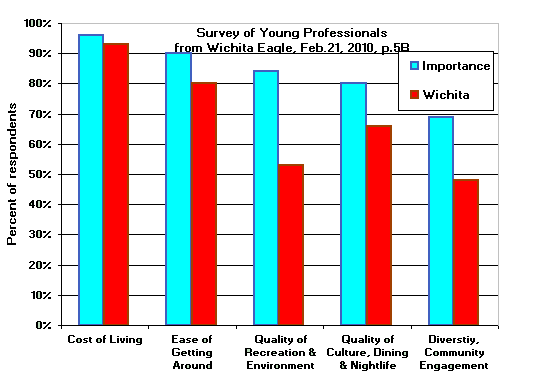 (Click graph to enlarge)
(Click graph to enlarge)
Wichita Eagle, Business News, Feb 21, 2010 .
Detailed poll results (data), only published in Sunday newspaper, Business News section; data not available with the online article, but graphed for you here (click to enlarge), and itemized in the table below:
This survey, and the related survey below, are being described in Wichita's official and business circles as "guidelines" for community development priorites
-- focusing on the desires of a narrow class of young, college-educated, upwardly mobile, mostly-white Wichitans -- many of them transients -- to the exclusion of everyone else. Various consultants advise that enticing these "high value" workers to Wichita (and keeping them here) is critical to attracting major corporations -- and their other jobs -- to Wichita (and keeping them here).
NOTE: Only YOUNG PROFESSIONALS were surveyed
-- thus NOT taking into consideration the MAJORITY of the community, nor even the majority of Wichita's young adults. Young "white collar" workers are studied. "Blue-collar" / "gray-collar" / "pink-collar" workers and homemakers (most of Wichita's population) are not considered. Nor are retirees, nor later-middle-aged workers, nor children, teens or even college students.
|
Survey Results - Young Professionals |
|
|
Feb.21, 2010 Wichita Eagle, Business Section, page 5B |
|
|
|
|
SURVEY RESULTS |
Believe this quality important |
Believe Wichita has this quality |
|
Cost of Living |
96% |
93% |
|
Ease of Getting Around |
90% |
80% |
|
Quality of Recreation & Environment |
84% |
53% |
|
Quality of Culture, Dining & Nightlife |
80% |
66% |
|
Diversity, Community Engagement |
69% |
48% |
|
|
|
 Young Professionals Survey
Young Professionals Survey
- File Format: PDF/Adobe Acrobat -
http://webfiles.wichita.edu/cedbr/YoungProfSurveyPP.pdf
by Wichita State University CEDBR
(Ctr. for Economic Development & Business Research)
A survey of selected young adults (NextGen YUPPIES ?).
Includes their
comments on local amenities
- including Downtown, the River, Old Town, variety of shopping and restaurants, ...
and complaints:
a lack of a progressive movement, progressive transportation options, etc.
NOTE: Only YOUNG PROFESSIONALS surveyed. Not taking into consideration the majority of the community, nor even the majority of Wichita professionals or young adults.
Participate - Let your voice be heard!
|
|